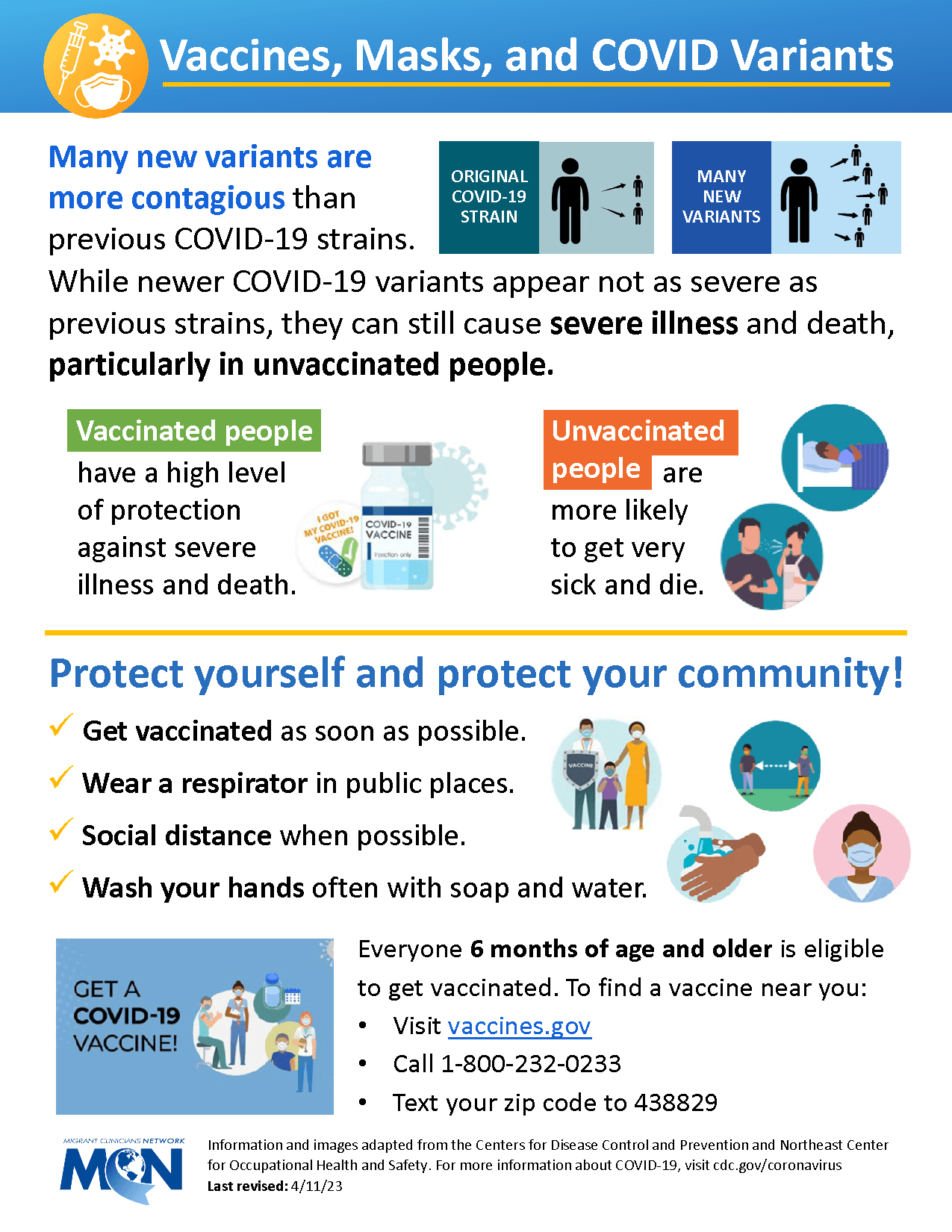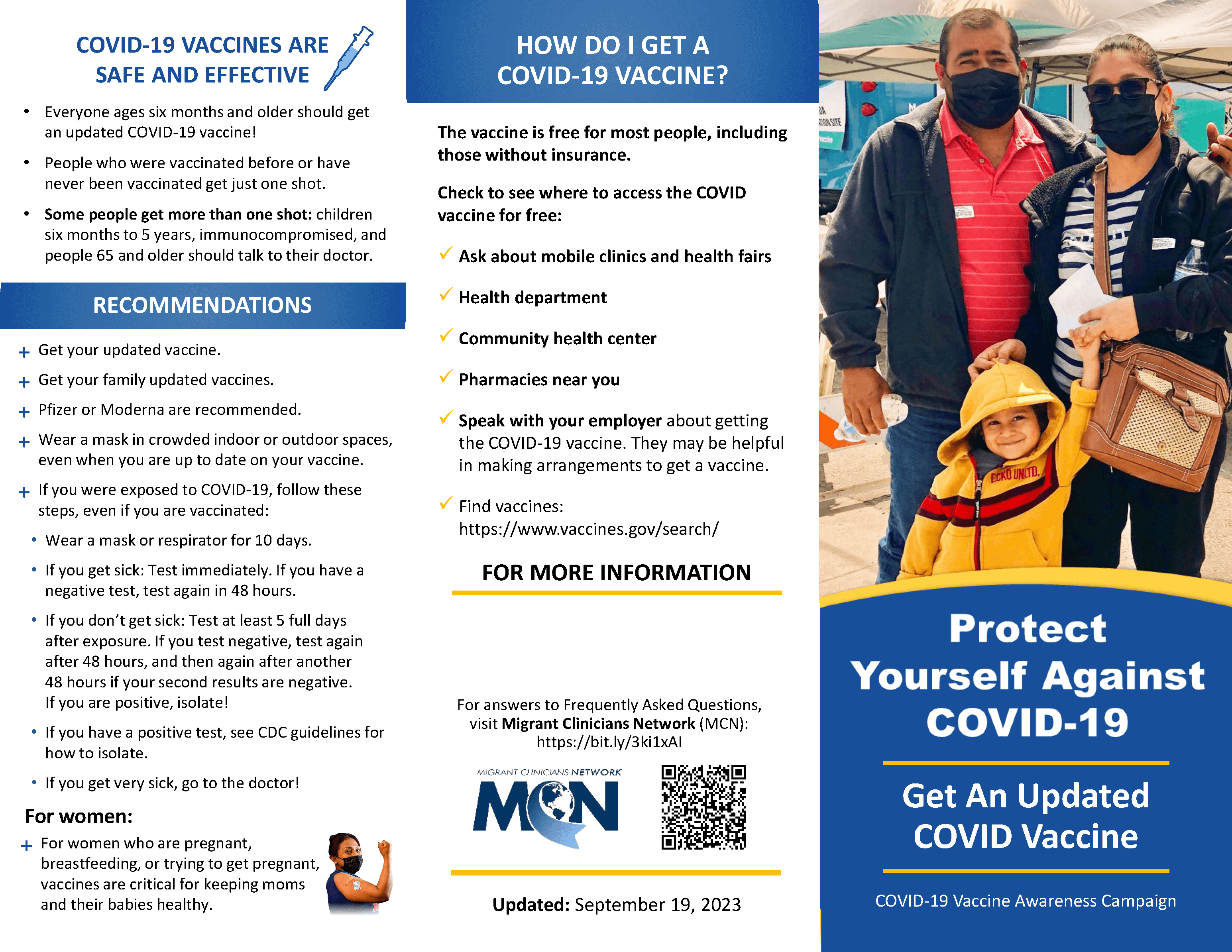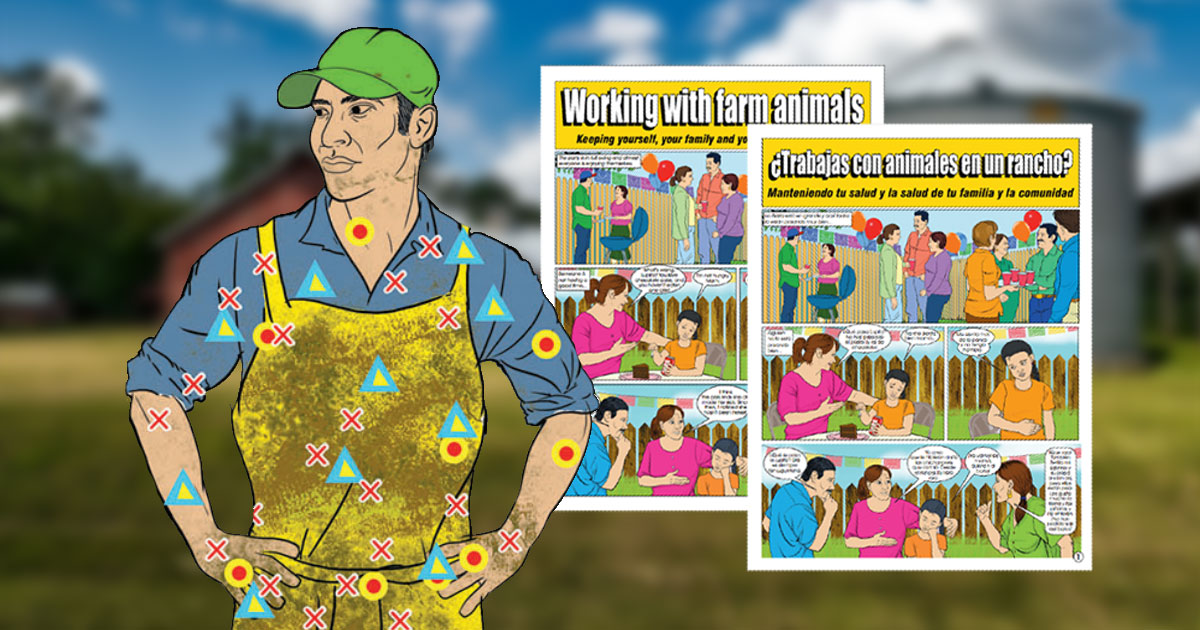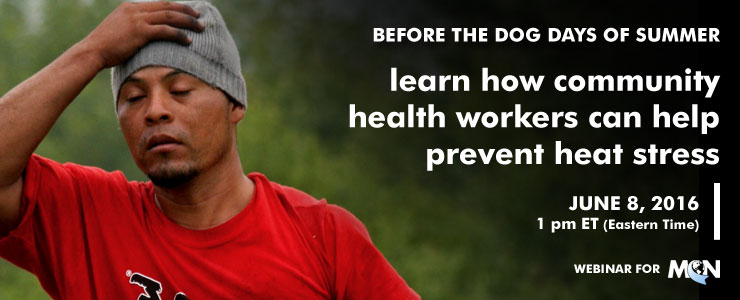


- 2023-10-05_General-COVID-Vaccine-Trifold_Handout_1.pdf (582.8 KB)
- 2023-10-05_General-COVID-Vaccine-Trifold_Handout_Template_1.pptx (2.67 MB)
- 2023-10-05_General-COVID-Vacuna-Tríptico_Material-de-apoyo_1.pdf (607.45 KB)
- 2023-10-05_General-COVID-Vacuna-Tríptico_Material-de-apoyo_Plantilla_1.pptx (2.66 MB)
- 2023-10-5_Modèl_depliyan_sou-vaksen-COVID-Jeneral_1.pdf (594.07 KB)
- 2023-10-5_Modèl_depliyan_sou-vaksen-COVID-Jeneral_1.pptx (2.58 MB)
This colorful vaccine calendar comic gives low-literacy information on vaccines and some information on why adults need immunizations, too. Available in high resolution to download and print into poster size.
This almost real-time map shows where COVID-19 cases have been reported, all over the world, which provides some perspective and allows for a visual understanding of the spread as it progresses.
NACHC’s new FAQ runs down a number of additional resources not covered here, specifically tailored for health centers.
HRSA’s new COVID-19 FAQs give some overview on the health center requirements around emergency preparedness as well as recommendations for communications from health centers.
This new poll, taken by Migrant Clinicians Network in January and February 2018, reflected the experiences of clinical staff from 26 states across the country. Respondents came from every corner of the clinic; occupations listed include Physician, Executive Director, Dental Assistant, Outreach Specialist, Therapist, Community Health Worker, Registered Nurse, and 24 other occupations. The poll follows up on MCN’s 2017 poll, in which 63 percent of respondents indicated that immigrant and mobile patients’ attitudes and feelings toward health care access had changed.
- Poll Results February 2018.pdf (92.89 KB)
"The Global Report on Internal Displacement presents the latest information on internal displacement worldwide caused by conflict, violence and disasters."
California's Medical Supervision Program is a biomonitoring program that measures cholinesterase activity in bloog samples from agricultural workers. Employers are required by law to contract with physicians who have registered for this program, all of whom are included in this list.
Safety and Health Practicesfor Nail Salon Workers and a Training Guide for Nail Salon Worker Safety and Health Outreach Program
- Best_Practices_HOPE.pdf (230 KB)
- Trainer_Guide_HOPE.pdf (1.34 MB)
Includes EPA manual "How to Comply With the 2015 Revised Worker Protection Standard For Agricultural Pesticides - What Owners and Employers Need To Know" and an excerpt specifically for clininicians regarding medical evaluation and respirator fit test. See also the medical evaluation questions in English and Spanish.
This 90-minute webinar was created for physicians, nurses, and other health professionals who treat and case manage patients with active TB. The webinar introduced the 2016 Official American Thoracic Society/Centers for Disease Control and Prevention/Infectious Diseases Society of America Clinical Practice Guidelines: Treatment of Drug-Susceptible Tuberculosis. This training highlighted the guidelines development process, the key changes in recommendations, and discussed the evidence supporting the changes. The webinar was originally presented on November 4, 2016. This training was jointly sponsored by all 5 RTMCCs.

Libro cómic educativo bilingüe sobre cómo prevenir las enfermedades zoonóticas. Desarrollado por MCN en colaboración con la Universidad Estatal de Ohio.
- Working with farm animals_1.pdf (13.33 MB)
- Trabajos con animales en un rancho_1.pdf (13.31 MB)
The 1999–2013 United States Cancer Statistics (USCS): Incidence and Mortality Web-based Report includes the official federal statistics on cancer incidence from registries that have high-quality data, and cancer mortality statistics. It is produced by the Centers for Disease Control and Prevention (CDC) and the National Cancer Institute (NCI). This report shows that in 2013, 1,536,119 Americans received a new diagnosis of invasive cancer, and 584,872 Americans died of this disease (these counts do not include in situ cancers or the more than 1 million cases of basal and squamous cell skin cancers diagnosed each year).
This year’s report features information on invasive cancer cases diagnosed during 2013, the most recent year of incidence data available, among residents of 49 states, six metropolitan areas, and the District of Columbia—geographic areas in which about 99% of the U.S. population resides. Incidence data are from CDC’s National Program of Cancer Registries (NPCR) and NCI’s Surveillance, Epidemiology, and End Results (SEER) Program. Data from population-based central cancer registries in these states and metropolitan areas meet the criteria for inclusion in this report.
The report also provides cancer mortality data collected and processed by CDC’s National Center for Health Statistics. Mortality statistics, based on records of deaths that occurred during 2013, are available for all 50 states and the District of Columbia.
The report also includes incidence rates and counts for Puerto Rico for 2009 through 2013 by sex and age, as well brain tumor and childhood cancer data.
USCS data are presented in the following applications—
- https://nccd.cdc.gov/uscs/?s_cid=govD_USCS2013_1
- http://links.govdelivery.com/track?type=click&enid=ZWFzPTEmbWFpbGluZ2lkPTIwMTYwNzA2LjYxMjE2OTcxJm1lc3NhZ2VpZD1NREItUFJELUJVTC0yMDE2MDcwNi42MTIxNjk3MSZkYXRhYmFzZWlkPTEwMDEmc2VyaWFsPTE3MDg5NzQwJmVtYWlsaWQ9dGx5b25zQG1pZ3JhbnRjbGluaWNpYW4ub3JnJnVzZXJpZD10bHlvbnNAbWlncmFudGNsaW5pY2lhbi5vcmcmZmw9JmV4dHJhPU11bHRpdmFyaWF0ZUlkPSYmJg%3D%3D&101=&https%3A%2F%2Fnccd_cdc_gov%2Fuscs%2F%3Fs_cid=govD_USCS2013_2
- http://links.govdelivery.com/track?type=click&enid=ZWFzPTEmbWFpbGluZ2lkPTIwMTYwNzA2LjYxMjE2OTcxJm1lc3NhZ2VpZD1NREItUFJELUJVTC0yMDE2MDcwNi42MTIxNjk3MSZkYXRhYmFzZWlkPTEwMDEmc2VyaWFsPTE3MDg5NzQwJmVtYWlsaWQ9dGx5b25zQG1pZ3JhbnRjbGluaWNpYW4ub3JnJnVzZXJpZD10bHlvbnNAbWlncmFudGNsaW5pY2lhbi5vcmcmZmw9JmV4dHJhPU11bHRpdmFyaWF0ZUlkPSYmJg%3D%3D&102=&https%3A%2F%2Fnccd_cdc_gov%2FDCPC_INCA%2F%3Fs_cid=govD_USCS2013_3
- http://links.govdelivery.com/track?type=click&enid=ZWFzPTEmbWFpbGluZ2lkPTIwMTYwNzA2LjYxMjE2OTcxJm1lc3NhZ2VpZD1NREItUFJELUJVTC0yMDE2MDcwNi42MTIxNjk3MSZkYXRhYmFzZWlkPTEwMDEmc2VyaWFsPTE3MDg5NzQwJmVtYWlsaWQ9dGx5b25zQG1pZ3JhbnRjbGluaWNpYW4ub3JnJnVzZXJpZD10bHlvbnNAbWlncmFudGNsaW5pY2lhbi5vcmcmZmw9JmV4dHJhPU11bHRpdmFyaWF0ZUlkPSYmJg%3D%3D&103=&https%3A%2F%2Fnccd_cdc_gov%2FStateCancerFacts%2F%3Fs_cid=govD_USCS2013_4

MCN and Farmworker Justice offer these guides to assist clinicians in understanding farmworker health and safety regulations. OSHA’s Field Sanitation Standard; EPA's Federal Insecticide, Fungicide, and Rodenticide Act (FIFRA); EPA's Food Quality Protection Act (FQPA); EPA’s Worker Protection Standard (WPS).
- OSHA's Field Sanitation Standard Clinician's Guide.pdf (747.53 KB)
- FIFRA FQPA Clinician's Guide.pdf (287.9 KB)
- WPS Clinician's Guide.pdf (843.35 KB)

MCN y Farmworker Justice ofrecen estas guías para ayudar a los médicos en la comprensión de regulaciones de salud y seguridad de los campesinos. Información de los Estándares de Saneamiento de la Administración de Seguridad y Salud Ocupacional (OSHA) para los campos; la Ley Federal de Insecticidas, Fungicidas y Rodenticidas (FIFRA) regulado por la Agencia de Protección Ambiental (EPA); la Ley de la Protección de la Calidad de los Alimentos (FQPA) también regulado por el EPA; y el estándar de protección del trabajador (WPS) establecido por el EPA.
- OSHA's Field Sanitation Standard Clinician's Guide.pdf (747.53 KB)
- FIFRA FQPA Clinician's Guide.pdf (287.9 KB)
- WPS Clinician's Guide.pdf (843.35 KB)

MCN and Farmworker Justice offer these guides to assist clinicians in understanding farmworker health and safety regulations. OSHA’s Field Sanitation Standard; EPA's Federal Insecticide, Fungicide, and Rodenticide Act (FIFRA); EPA's Food Quality Protection Act (FQPA); EPA’s Worker Protection Standard (WPS).
- OSHA's Field Sanitation Standard Clinician's Guide.pdf (747.53 KB)
- FIFRA FQPA Clinician's Guide.pdf (287.9 KB)
- WPS Clinician's Guide.pdf (843.35 KB)
The 1999–2013 United States Cancer Statistics (USCS): Incidence and Mortality Web-based Report includes the official federal statistics on cancer incidence from registries that have high-quality data, and cancer mortality statistics. It is produced by the Centers for Disease Control and Prevention (CDC) and the National Cancer Institute (NCI). This report shows that in 2013, 1,536,119 Americans received a new diagnosis of invasive cancer, and 584,872 Americans died of this disease (these counts do not include in situ cancers or the more than 1 million cases of basal and squamous cell skin cancers diagnosed each year).
This year’s report features information on invasive cancer cases diagnosed during 2013, the most recent year of incidence data available, among residents of 49 states, six metropolitan areas, and the District of Columbia—geographic areas in which about 99% of the U.S. population resides. Incidence data are from CDC’s National Program of Cancer Registries (NPCR) and NCI’s Surveillance, Epidemiology, and End Results (SEER) Program. Data from population-based central cancer registries in these states and metropolitan areas meet the criteria for inclusion in this report.
The report also provides cancer mortality data collected and processed by CDC’s National Center for Health Statistics. Mortality statistics, based on records of deaths that occurred during 2013, are available for all 50 states and the District of Columbia.
The report also includes incidence rates and counts for Puerto Rico for 2009 through 2013 by sex and age, as well brain tumor and childhood cancer data.
USCS data are presented in the following applications—
- https://nccd.cdc.gov/uscs/?s_cid=govD_USCS2013_1
- http://links.govdelivery.com/track?type=click&enid=ZWFzPTEmbWFpbGluZ2lkPTIwMTYwNzA2LjYxMjE2OTcxJm1lc3NhZ2VpZD1NREItUFJELUJVTC0yMDE2MDcwNi42MTIxNjk3MSZkYXRhYmFzZWlkPTEwMDEmc2VyaWFsPTE3MDg5NzQwJmVtYWlsaWQ9dGx5b25zQG1pZ3JhbnRjbGluaWNpYW4ub3JnJnVzZXJpZD10bHlvbnNAbWlncmFudGNsaW5pY2lhbi5vcmcmZmw9JmV4dHJhPU11bHRpdmFyaWF0ZUlkPSYmJg%3D%3D&101=&https%3A%2F%2Fnccd_cdc_gov%2Fuscs%2F%3Fs_cid=govD_USCS2013_2
- http://links.govdelivery.com/track?type=click&enid=ZWFzPTEmbWFpbGluZ2lkPTIwMTYwNzA2LjYxMjE2OTcxJm1lc3NhZ2VpZD1NREItUFJELUJVTC0yMDE2MDcwNi42MTIxNjk3MSZkYXRhYmFzZWlkPTEwMDEmc2VyaWFsPTE3MDg5NzQwJmVtYWlsaWQ9dGx5b25zQG1pZ3JhbnRjbGluaWNpYW4ub3JnJnVzZXJpZD10bHlvbnNAbWlncmFudGNsaW5pY2lhbi5vcmcmZmw9JmV4dHJhPU11bHRpdmFyaWF0ZUlkPSYmJg%3D%3D&102=&https%3A%2F%2Fnccd_cdc_gov%2FDCPC_INCA%2F%3Fs_cid=govD_USCS2013_3
- http://links.govdelivery.com/track?type=click&enid=ZWFzPTEmbWFpbGluZ2lkPTIwMTYwNzA2LjYxMjE2OTcxJm1lc3NhZ2VpZD1NREItUFJELUJVTC0yMDE2MDcwNi42MTIxNjk3MSZkYXRhYmFzZWlkPTEwMDEmc2VyaWFsPTE3MDg5NzQwJmVtYWlsaWQ9dGx5b25zQG1pZ3JhbnRjbGluaWNpYW4ub3JnJnVzZXJpZD10bHlvbnNAbWlncmFudGNsaW5pY2lhbi5vcmcmZmw9JmV4dHJhPU11bHRpdmFyaWF0ZUlkPSYmJg%3D%3D&103=&https%3A%2F%2Fnccd_cdc_gov%2FStateCancerFacts%2F%3Fs_cid=govD_USCS2013_4

DATE RECORDED: June 22, 2016
PRESENTED BY: Kerry Brennan
This material will be produced under grant number SH-27640-15-60-F-48-SH5 from the Occupational Safety and Health Administration, U.S. Department of Labor. It will not necessarily reflect the views or policies of the U.S. Department of Labor, nor does mention of trade names, commercial products, or organizations imply endorsement by the U.S. Government.

DATE RECORDED: June 8, 2016
PRESENTED BY: Juliana Simmons, MSPH, CHES
This material will be produced under grant number SH-27640-15-60-F-48-SH5 from the Occupational Safety and Health Administration, U.S. Department of Labor. It will not necessarily reflect the views or policies of the U.S. Department of Labor, nor does mention of trade names, commercial products, or organizations imply endorsement by the U.S. Government.
- https://youtu.be/qcCci3GQs04
- http://www.migrantclinician.org/
- https://www.osha.gov/SLTC/heatstress/prevention.html
- http://www.farmworkerjustice.org/sites/default/files/FJpesticidetrainingspanish2016.pdf
- https://www.osha.gov/SLTC/heatstress/index.html
- https://www.osha.gov/SLTC/heatillness/index.html
- https://www.osha.gov/SLTC/heatstress/industry_resources.html
- http://www.dir.ca.gov/dosh/heatIllnessQA.html
- http://www.lni.wa.gov/Safety/Topics/AtoZ/HeatStress/
- http://en.hesperian.org/hhg/Workers%27_Guide_to_Health_and_Safety:Dangers_from_heat
- http://www.naplesnews.com/news/crime/report-farmworkers-death-should-have-been-prevented-2738c212-4e00-109c-e053-0100007fd972-363310521.html
- http://www.cdc.gov/niosh/topics/heatstress/heatrelillness.html
The U.S. Environmental Protection Agency’s (EPA) Worker Protection Standard (WPS) provides basic workplace protections to farmworkers and pesticide handlers to minimize the adverse effects of pesticide exposure. EPA announced major revisions to the WPS in September 2015. MCN and FJ's fact sheet provides a summary of the revised regulation.
- WPS-2015.pdf (981.69 KB)
In 2015, for the first time in over 20 years, the Environmental Protection Agency updated the Worker Protection Standard (WPS). The WPS provides basic workplace protections for agricultural workers to reduce the risk of pesticide exposre. This issue brief overviews the major revisions that are particularly relevant for clinicians caring for agricultural workers.
- WPS_MCN_FJ_IssuesBrief2016.pdf (3.02 MB)

ACA Toolkit:
Available in English and Spanish
Health Insurance Guide:
Available in English and Spanish and Haitian Creole
Older Guides:
Available in English, Spanish, and Haitian Creole for workers on employer-provided health insurance
Created by Farmworker Justice.
- http://www.farmworkerjustice.org/sites/default/files/FJ_ACA_Fact_Sheet_Employer_Provided_Health_Insurance_FINAL.pdf
- http://www.farmworkerjustice.org/sites/default/files/FJ_ACA_Fact_Sheet_Employer_Provided_Health_Insurance_SPANISH_FINAL.pdf
- http://www.farmworkerjustice.org/sites/default/files/FJ_ACA_Fact_Sheet_Employer_Provided_Health_Insurance_CREOLE_FINAL.pdf
The National LGBT Health Education Center provides educational programs, resources, and consultation to health care organizations with the goal of optimizing quality, cost-effective health care for lesbian, gay, bisexual, and transgender (LGBT) people.
http://www.asbestosdiseaseawareness.org/
ADAO is the largest independent nonprofit in the U.S. dedicated to preventing asbestos exposure, eliminating asbestos-related diseases, and protecting asbestos victims' civil rights through education, advocacy, and community initiatives.
The Inter-professional Oral Health Faculty Toolkit, developed by the Oral Health Nursing Education and Practice program, is now available.The toolkit is an innovative web-based open source product intended to facilitate integration of oral-systemic health content and clinical competencies into nurse practitioner and midwifery curricula.
"Abstract: Unathorized (undocumented) immigrants are less likely than other residents of the United States to have health insurance. The American College of Obstetricians and Gynecologists has long supported a basic health care package for all women living within the United States without regard to their country of origin or documentation. Providing access to qualify health care for unauthorized immigrants and their children, who often were born in the United States and have U.S. citizenship, is essential to improving the nation's publc health."
- ACOGOpinionNo627Mar2015.pdf (1.01 MB)
Migrant Clinicians Network, Inc. (MCN) will work during the next two years to engage members of our clinical network and all relevant stakeholders to advance health justice for the mobile poor. Our advocacy and education priorities focus on safe and legal entry into the United States, as well as strong and equal protection for workers in all occupations. Advancement in these areas creates the greatest opportunity for all to access high-quality, affordable healthcare.
- Comprehensive Immigration Reform
- Access to Health Care
- MCNAdcovacyAgendaFinal.pdf (148.62 KB)
Recently in the UK, there has been research supporting midwifery care. Due to this research, the UK has made some policy changes in regards to maternity. Midwifery care has been shown to be more safe for women with uncomplicated pregnancies and because of these new policies, the United States may follow in their footsteps.
- NICEGuidelinesSummary.pdf (442.38 KB)